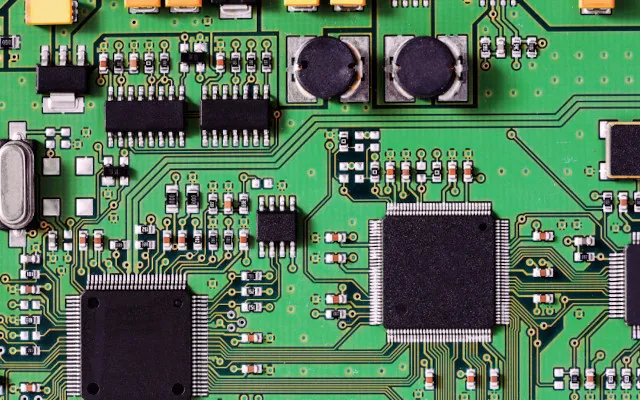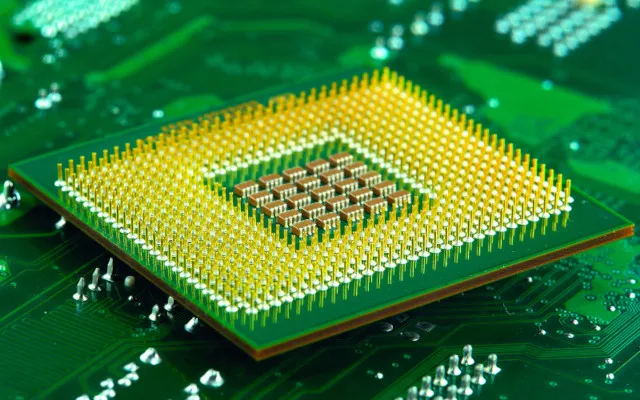“Microprocessor” and “integrated circuit” are often used interchangeably in electronics but refer to distinct concepts. While both are critical in the digital age, understanding their differences is essential for anyone interested in technology.
This article delves into the nuances that set microprocessors apart from integrated circuits.
What is an Integrated Circuit?
An integrated circuit (IC), often called a chip or a microchip, is a marvel of modern engineering that has revolutionized the electronics industry. It is a compact, flat piece made typically of silicon, onto which many tiny electronic components are embedded.
These components, primarily transistors but also resistors and capacitors, are interconnected to perform various electronic functions.

The Evolution of Integrated Circuits
- Historical Context: The development of the integrated circuit in the 1950s and 1960s marked a significant milestone. Before ICs, electronic circuits were composed of discrete components, which made devices bulky and complex.
- Miniaturization: The advent of ICs allowed for the miniaturization of electronic devices. This was a groundbreaking shift, enabling the production of smaller, more efficient, and more reliable electronic gadgets.
Types of Integrated Circuits
- Digital vs. Analog: ICs can be categorized into digital (microprocessors and memory chips) and analog (amplifiers and radio receivers). Digital ICs work with binary data, while analog ICs deal with continuously variable signals.
- Complexity Levels: They range from simple small-scale integration (SSI) circuits with a few transistors to complex large-scale integration (LSI) and very large-scale integration (VLSI) circuits containing millions of transistors.
The Manufacturing Process
- Photolithography: The production of ICs involves a sophisticated process called photolithography, where patterns are optically transferred to the semiconductor wafer.
- Layering: Multiple layers of different materials are laid down and patterned to form an interconnected network of components.
Impact on Technology and Industry
- Versatility: ICs are the backbone of modern electronic devices. Their ability to perform various functions makes them indispensable in the consumer electronics and aerospace industries.
- Innovation Driver: The evolution of IC technology, particularly the pursuit of smaller and more efficient designs, continues to drive innovation in computing, telecommunications, and robotics.
Integrated circuits represent a foundational technology in the electronic world. Their ability to house many miniaturized components on a small silicon chip has paved the way for today’s advanced electronic devices.
From smartphones and computers to sophisticated medical equipment and space technology, ICs are at the heart of numerous modern innovations.
What is a Microprocessor?
A microprocessor is a sophisticated and integral component in modern computing and electronics. Essentially serving as the brain of a computer, it is a specialized form of integrated circuit designed to perform many computing tasks.

The Core Functionality of a Microprocessor
- Central Processing Unit (CPU): At its heart, a microprocessor functions as the CPU of a computer or electronic device. It interprets and executes instructions from the device’s memory, handling everything from basic commands to complex computational tasks.
- Binary Processing: Microprocessors operate using binary language (0s and 1s). They process these binary instructions to perform arithmetic, data handling, and decision-making operations.
Architecture and Design
- ALU and Control Unit: The architecture of a microprocessor typically includes an Arithmetic Logic Unit (ALU) for performing mathematical and logical operations and a Control Unit (CU) for interpreting and executing instructions.
- Registers and Buses: Registers are used for temporary data storage, while buses (data, address, and control buses) facilitate data transmission within the microprocessor and between external components.
The Evolution of Microprocessors
- Historical Milestones: The development of the first microprocessor in the early 1970s marked a pivotal moment in computing, leading to the rise of personal computers and a revolution in digital technology.
- Advancements in Technology: Over the decades, microprocessors have evolved significantly, becoming faster, more powerful, and more energy-efficient. Moore’s Law often quantifies this evolution, which observes that the number of transistors on a microprocessor doubles approximately every two years.
Applications Beyond Computers
- Versatile Usage: While commonly associated with computers, microprocessors are also embedded in many other devices, such as smartphones, appliances, automobiles, and industrial machinery.
- Embedded Systems: In embedded systems, microprocessors are tailored to control and manage specific operations, making them integral in systems ranging from household electronics to advanced aerospace technology.
The Future of Microprocessors
- Innovation and Trends: The future of microprocessors lies in continued miniaturization, increased processing power, and integration with emerging technologies like AI and IoT (Internet of Things).
- Challenges and Opportunities: As microprocessors become more advanced, they present challenges in heat management and energy efficiency but also offer opportunities for groundbreaking advancements in computing and electronics.
Understanding the role and functionality of a microprocessor is crucial for grasping modern technology’s capabilities and limitations. As the primary computing engine of electronic devices, microprocessors have revolutionized how computers operate and paved the way for countless innovations in various technological fields.
Key Differences Between Microprocessors and Integrated Circuits
Functionality
- Integrated Circuits: ICs can be designed to perform various electronic functions, such as amplification, oscillation, and signal processing. They are not limited to processing and computing tasks.
- Microprocessors: These are designed exclusively for computational tasks. They execute a series of stored instructions called programs.
Complexity
- Integrated Circuits: The complexity of ICs can vary widely. Some might be simple, performing basic functions like timing or light flashing, while others, like microcontrollers, are more complex.
- Microprocessors: Generally, microprocessors are more complex than standard ICs. They are capable of executing complex instructions and handling various operations simultaneously.
Components
- Integrated Circuits: An IC might contain a combination of resistors, transistors, and capacitors, depending on its purpose.
- Microprocessors: They consist of a control unit, an arithmetic logic unit (ALU), registers, and interfaces for input/output operations.
Applications
- Integrated Circuits: ICs are used in almost every electronic device, from microwaves and cell phones to industrial machines.
- Microprocessors: These are primarily used in computers and related devices like servers and routers. They can also be found in more complex consumer electronics.
How Do a Motherboard and a Microprocessor Communicate to Execute Tasks?
The communication between a motherboard and a microprocessor occurs through a system of buses and interfaces that connect the microprocessor (CPU) to various components on the motherboard.
Here’s a simplified overview of this complex process:
- Buses: The motherboard houses a network of electrical pathways known as buses. These buses transmit data, addresses (which specify where data should be read from or written to), and control signals between the microprocessor and other components like memory (RAM), storage devices, and input/output devices.
- Chipset: The chipset on the motherboard plays a pivotal role in this communication. It acts as a traffic controller, managing the data flow between the microprocessor and peripherals. The chipset is divided into two main parts: the Northbridge and the Southbridge (though modern architectures may integrate these functions into a single chip). The Northbridge typically handles high-speed communication with the microprocessor, RAM, and graphics card, while the Southbridge manages input/output (I/O) functions and slower peripherals.
- Memory Controller: In some systems, the memory controller, traditionally part of the Northbridge, is now integrated directly into the microprocessor. This direct integration allows for faster communication with the RAM, improving the system’s overall performance by reducing the latency in memory access.
- Input/Output (I/O) Ports and Expansion Slots: The motherboard provides various I/O ports and expansion slots for peripherals (like keyboards, mice, and printers) and expansion cards (such as graphics cards). The microprocessor communicates with these devices through the motherboard’s circuitry, enabling the system to execute tasks based on user input or predefined programs.
- BIOS/UEFI Firmware: When a computer is powered on, the microprocessor executes instructions from the BIOS (Basic Input/Output System) or UEFI (Unified Extensible Firmware Interface) stored on the motherboard. This firmware initiates a series of tests known as the POST (Power-On Self Test) and begins loading the operating system from a storage device into the RAM.
Conclusion
While all microprocessors are integrated circuits, not all integrated circuits are microprocessors. Understanding this distinction is crucial in the realm of electronics and computing.
Microprocessors are specialized ICs designed specifically for computing tasks, whereas integrated circuits have a broader range of functions across various electronic devices. This knowledge is foundational for anyone delving into electronics or computer science.
Frequently Asked Questions
Can a microprocessor function independently?
No, microprocessors need external components like memory and input/output interfaces to function.
Are all ICs microprocessors?
No, microprocessors are a specific type of IC designed for computational tasks.
How has the development of ICs impacted technology?
The development of ICs has revolutionized technology, enabling the miniaturization and increased power of electronic devices.





